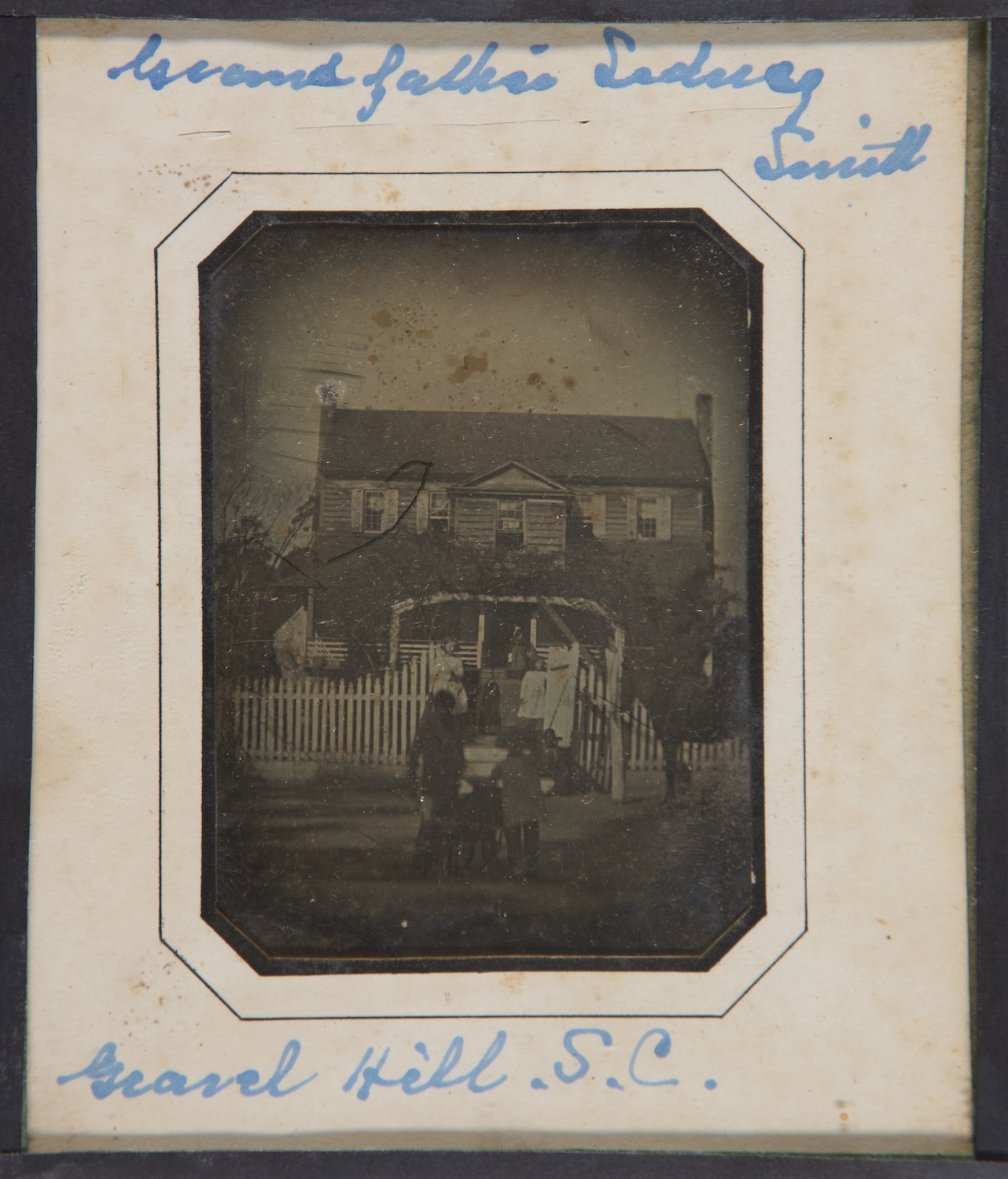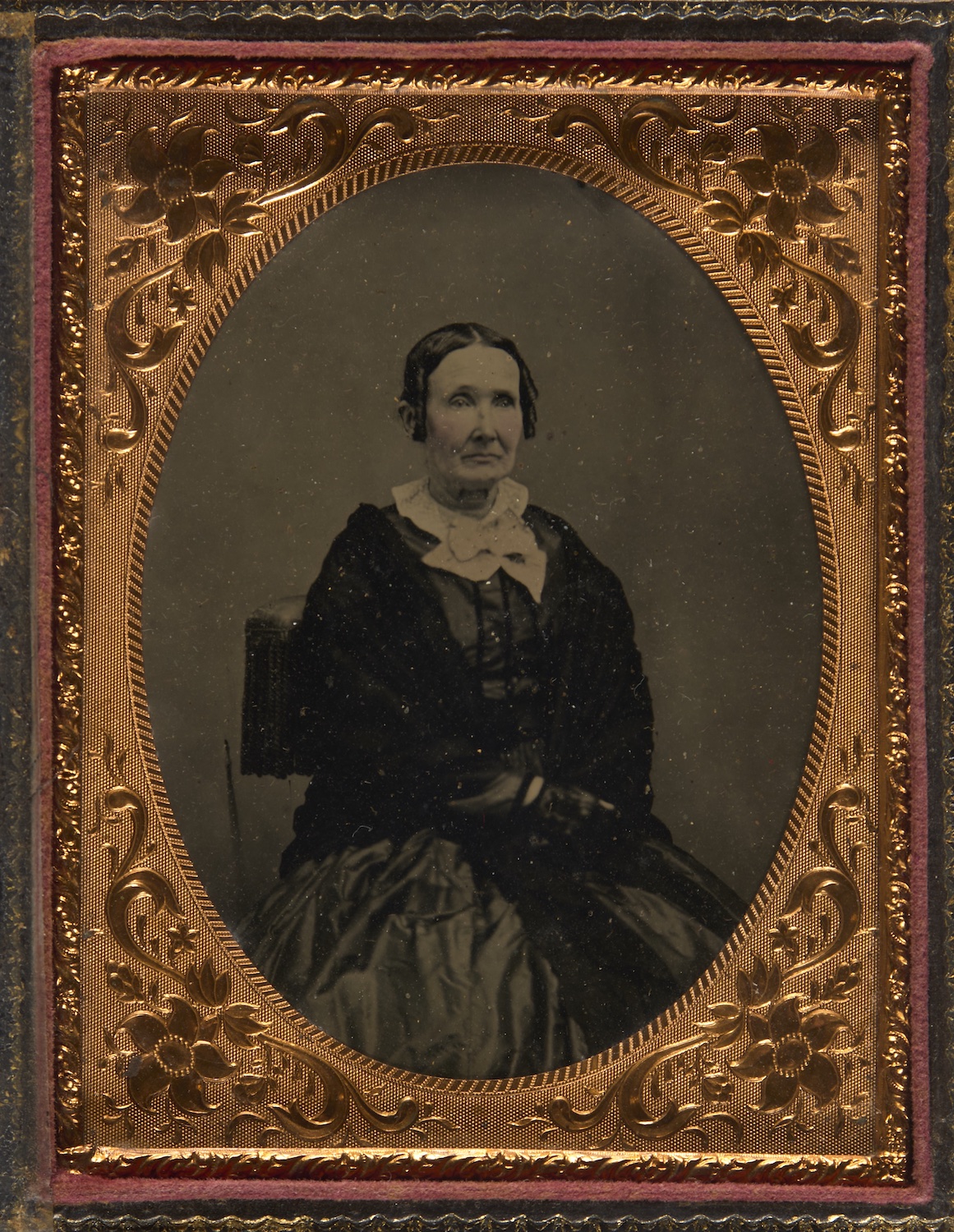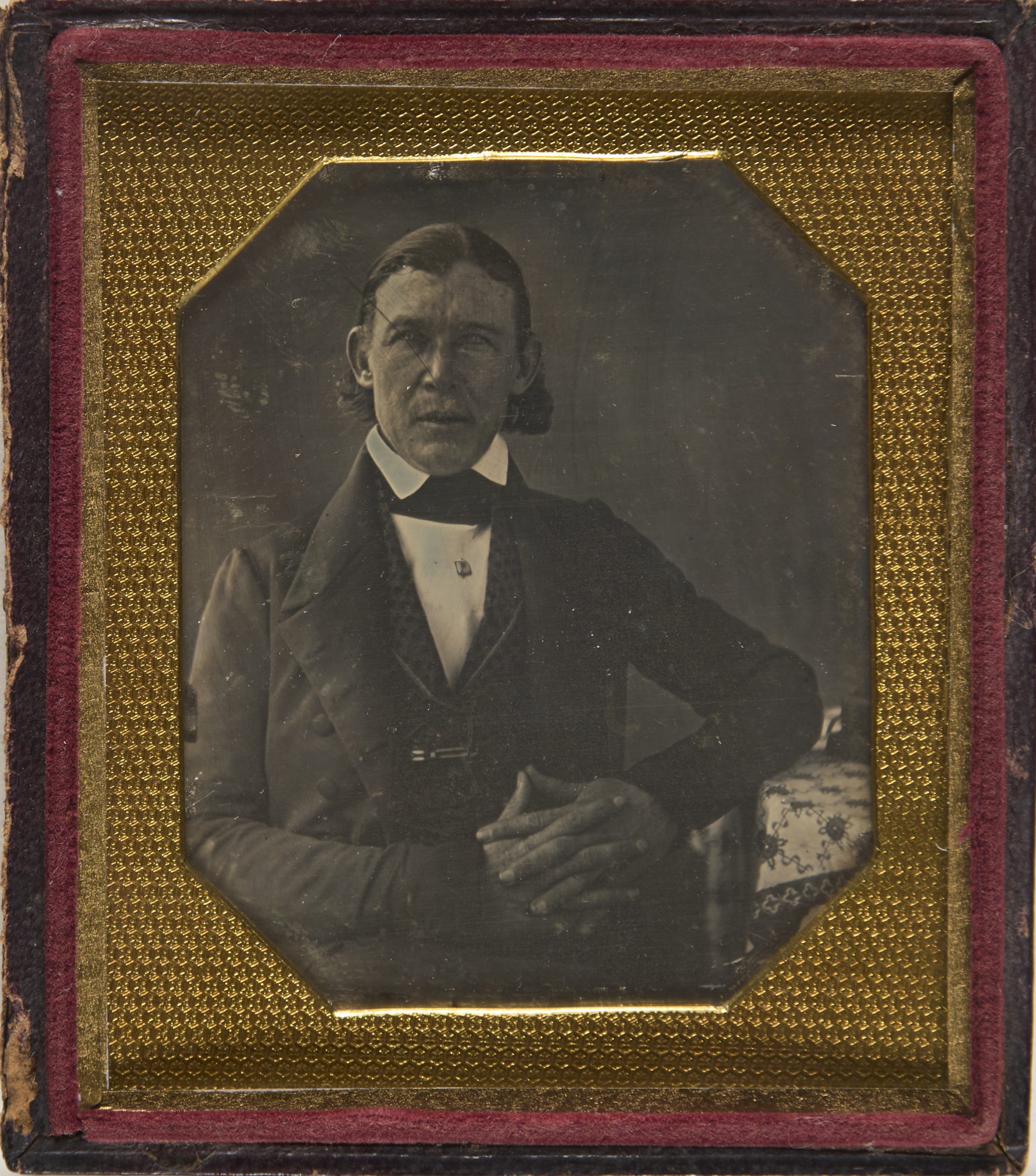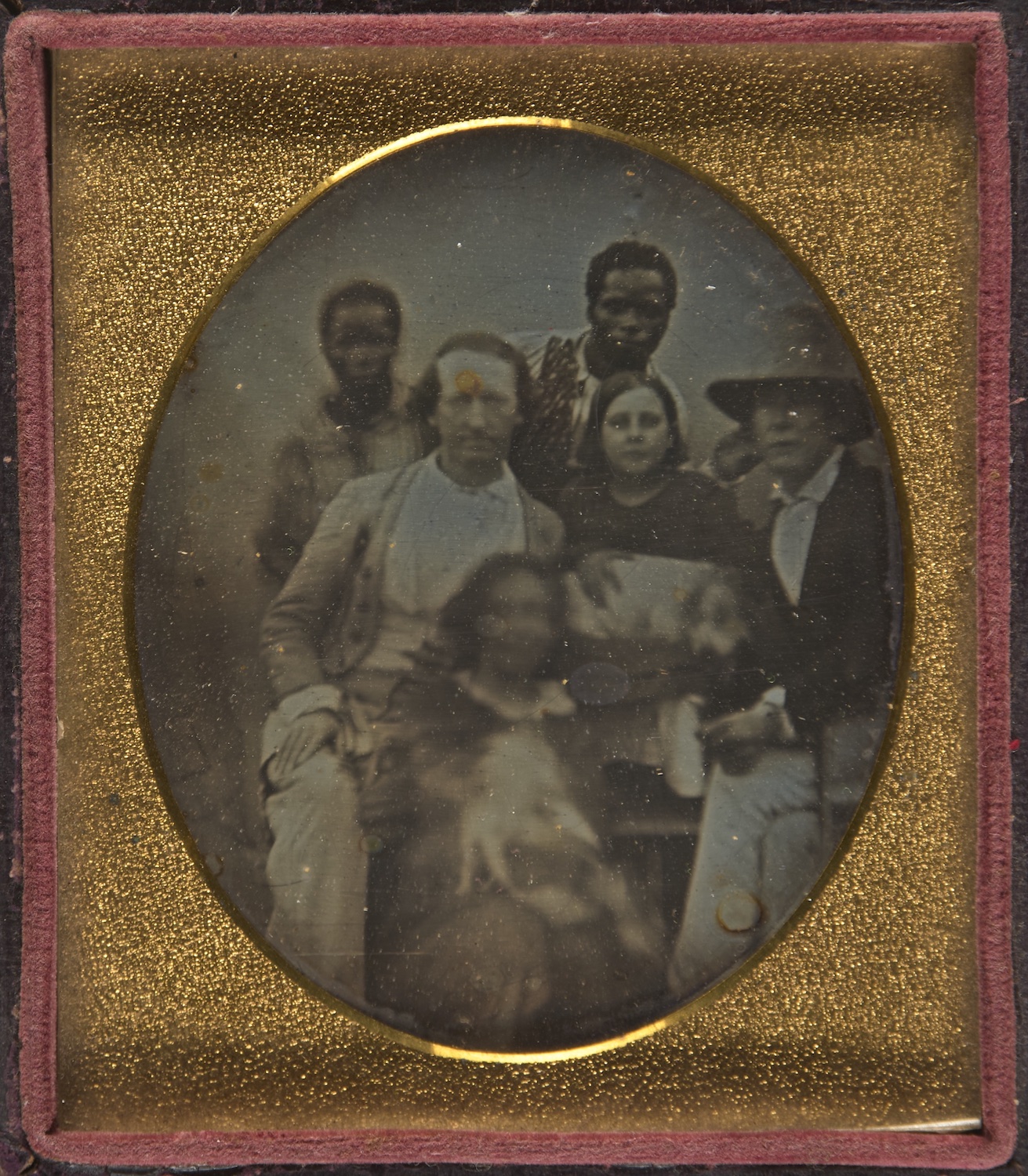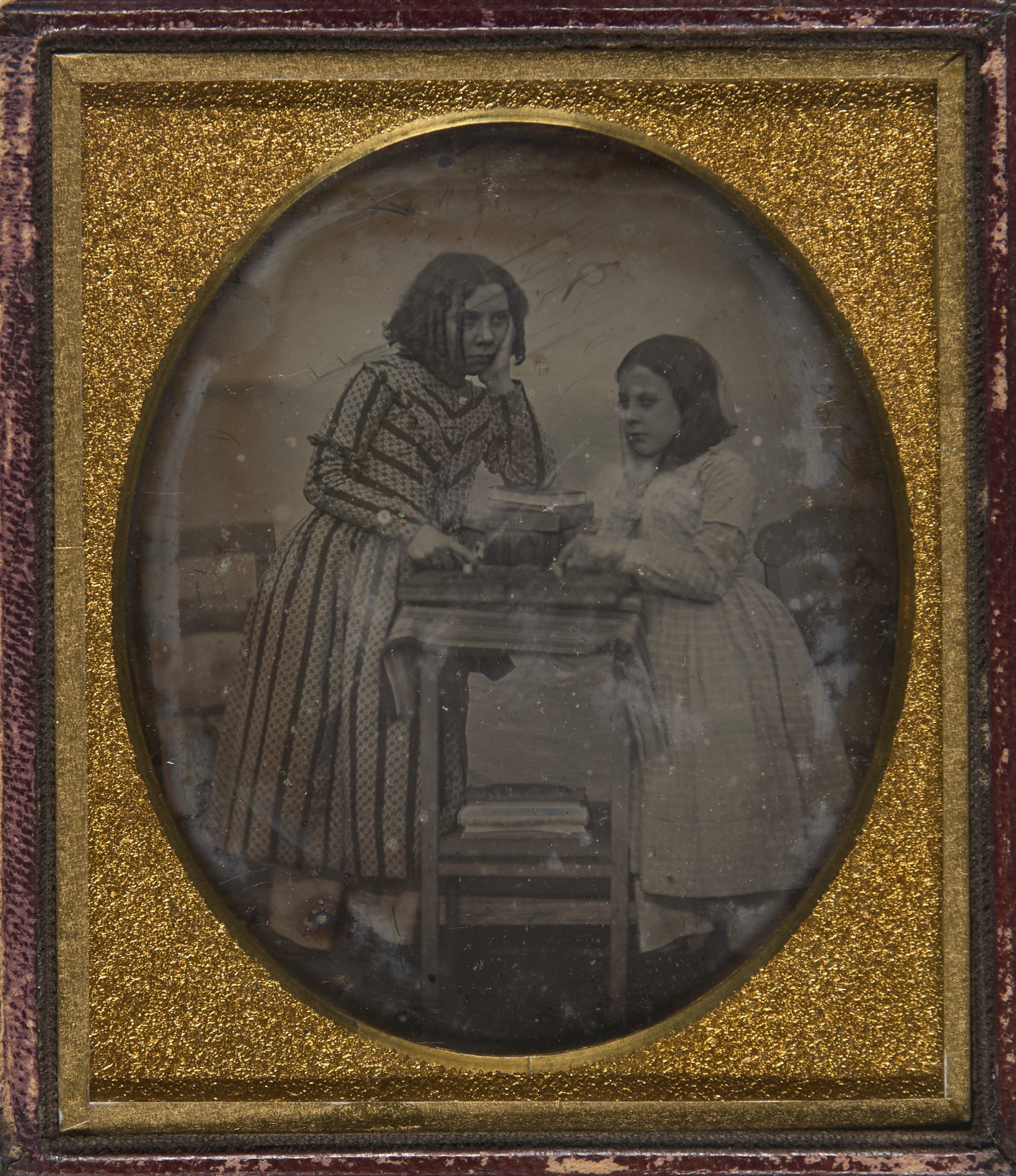the earliest daguerreotype of an identified plantation owner posing with the African Americans he enslaved
(Slavery in South Carolina.). A collection of images associated with South Carolina physician and plantation owner Sidney Smith
South Carolina, 1845-50
1845-1850 (four daguerreotypes) and ca. 1855-1860 (three ambrotypes), plus three early tintype copy images. 10 items.
A unique survival. This important collection of largely identified photographs documents the home and family of Dr. Sidney Smith and those he enslaved at Gravel Hill, his South Carolina plantation. The collection includes an extraordinary daguerreotype depicting Dr. Smith, his two daughters, and his brother, posed together with two enslaved African American men. This is one of the earliest known images—if not the very earliest photograph—of an identified plantation owner posing with enslaved African Americans.
The photographs :
1. Quarter plate daguerreotype (4 x 3 1/8 in.) of Gravel Hill Plantation, near Robertville, St. Peter’s Parish, Beaufort District, South Carolina. Ca. mid-to-late 1840s. Manuscript notation on passe-partout mat, “Grandfather Sidney Smith, Gravel Hill S.C.” The image shows the plantation house with various figures engaged in an unidentified activity, with a horse tied to a picket fence. The two girls in white may be Sidney Smith’s daughters Arabella (b. 1832) and Julia (b. 1837), and the others may be enslaved African American children. An enslaved African American subject stands on the steps in the background. In the foreground are two figures with an unknown object, perhaps a dog cart or a bone-shaker bicycle. In front of the house is a heavily-vined grape arbor presumably connected with Smith’s efforts in viniculture.
2. A quarter plate tintype copy of the above daguerreotype.
3. Sixth plate daguerreotype of Sidney Smith, his daughters Arabella and Julia, his brother James Laurens Smith, and two unidentified African American men, almost certainly enslaved men. Ca. mid-1840s-1850. One of the girls is blurred because she is hold a struggling dog. Accompanied by the envelope in which the daguerreotype was discovered, with penciled notation about the subjects as well as a tentative date of “1850 or thereabout.”
4. Sixth plate daguerreotype of Smith’s daughters, Arabella and Julia, pointing to a book and an unidentified object. Ca. mid-1840s-1850.
5. Sixth plate daguerreotype of Sidney Smith. Ca. 1845. Smith appears to be wearing a mourning band on his coat, suggesting that the image was made following the death of his first wife Eliza in March 1845.
6. Sixth plate tintype copy of the above portrait.
7. Sixth plate tintype portrait of Maria King Smith, second wife of Sidney Smith, with an infant, possibly William King Smith. A period copy image.
8. Sixth plate ambrotype of William King Smith, son of Sidney and Maria Smith, possibly as a cadet. Ca 1850s.
9. Quarter plate ambrotype of Sarah Smith, sister of Sidney and James Laurens Smith, aunt to Arabella and Julia. Ca 1850s-1860s.
10. Sixth plate ambrotype of Rosa Nicholes, sister of Maria Smith, with “Eddie” Postell, possibly the Edward Postell who was killed in action in 1863 at Fort Wagner. Ca 1850s.
Dr. Sidney Smith
Sidney Smith was born in 1805 in or near Beaufort, SC, the son of William Smith, a man of moderate wealth, and Elizabeth Wilson Smith of Philadelphia, reportedly a Quaker. Sidney was sent to Yale College and subsequently studied medicine in Ohio. His younger brother James Laurens Smith (b. 1809) studied law, but he apparently never practiced, devoting himself instead to agriculture. Sidney Smith married Eliza Lawton in 1829. The two had several children including daughters Arabella and Julia. Smith was apparently practicing medicine in the vicinity of Robertville, South Carolina as well as trying his hand at being a planter. In 1831, he appears in the Lawton Family Papers as having been paid two dollars for “expirating a Fungus Tumor from the head of Little Negro Shiloh” (Inabinett 1963). His name appears in several land transactions in the upper St. Peter’s Parish in Beaufort District, where he experimented with various crops.
Smith’s experiments with wine received wide-ranging coverage in the press. A notice in the Boston Daily Atlas of 28 December 1844, printed a report from a Savannah newspaper: “This editor of the Savannah Republican has samples of eight kinds of wine, made by Dr. Sidney Smith, of Robertville, Beaufort District, S.C. They are pure juice of the grape, without the addition of any spirits whatever. One of the specimens is from the vintage of 1833, another from that of ’38, and the other six from that of the present year. They differ in flavor, according to the species of grape from which they were expressed … Dr. S. has on hand some 800 gallons of those wines, which he finds useful for all medicinal and culinary purposes.”
Smith’s first wife, Eliza, died in 1845 at the age of 37, possibly explaining her absence from the group portrait. In 1846, Smith married Maria Ann King, with whom he would have two children who survived into adulthood, William King Smith (b. 1846) and Walter Watson Smith (b. 1849).
By 1850 Smith and most of his family had left Gravel Hill and relocated to Marietta, Georgia, where he acquired another plantation, Rockford, near Marietta. By this time Smith had acquired 74 slaves according to the 1850 Slave Schedules of the United States Census. He continued to run Gravel Hill as an absentee owner from Georgia.
In 1853 Smith sold Gravel Hill (then comprising 700 acres) and his other plantation properties in the Robertville area to John Goldwire Lawton in 1853, according to genealogical records at the Heritage Library Foundation. Smith’s Gravel Hill home appears to have been on the site of present-day Gravel Hill Plantation, the ca. 1910 hunting preserve near Robertville on the National Register of Historic Places. The elaborately decorated center-hall plan home, as well as the town of Robertville, was burned by W.T. Sherman’s troops in 1865.
After the war the land was sold to Northern buyers. Newer structures were apparently built on the foundations of the original Gravel Hill around 1910 when it was refashioned as a gentleman’s hunting plantation. Dr. Smith and his wife Maria died in 1856. Their sons Walter and William became wards of Smith’s brother James, who himself apparently died in 1865. Walter Smith was a student at the Georgia Military Institute when it closed at the time of W. T. Sherman’s approach in 1864. At the age of 14, he and the other cadets were sent to guard the river crossings in the approaches to Atlanta. With his brother William, Walter served in Confederate units until the end of the Civil War. Sidney Smith’s sister Sarah, known as “Aunt Sarah” to Walter and William Smith, wrote vivid letters describing the evacuation of Marietta and her flight to Atlanta.
While no documentary evidence of the Smith family’s views on slavery has been found, Susan E. Geoffrey claims in her academic paper, “A Southern Family in Transition, 1830-1865,” that Sidney and his siblings were “reasonably humane to their slaves according to the standards of their society.” Geoffrey adds that Sidney’s sisters Sarah and Hannah developed an interest in educating their brothers’ enslaved children. Dexter’s biographical sketch of Smith notes that Smith “opposed strenuously the act of nullification in South Carolina, and by his personal efforts retarded the action of that State.” Smith’s brother James provided in his 1853 will that every tenth(!) child born into slavery in the estate should at age eighteen be granted freedom to be facilitated by the Colonization Society.
The photographers
The photographers of these images are unidentified, but it appears that Smith himself may have made two of the daguerreotypes. Biographical Sketches of the Graduates of Yale College with Annals of the College History vol. 7 (1913) notes of Smith: “He was a man of unusual mental gifts, an earnest student and devoted to the community and mankind. When the art of the daguerreotype was first introduced, he was a pioneer in cultivating it in the South.”
Based on his interest in the “art of the daguerreotype,” it is possible that Smith created the daguerreotypes himself, perhaps with the aid of an assistant so he could be included in certain images, most notably the group portrait. The informal group portrait shows a relaxed family posing together. Smith appears to have moved into the frame at the last moment after setting up the shot. Likewise the subjects in the Gravel Hill daguerreotype are in casual poses, as if they are in a Daguerreian snapshot of the family rather than formally arranged portraits.
Dating
The approximate dating of the featured images has been determined based on the estimated ages of Smith’s daughters, Arabella and Julia, who are pictured in two (or perhaps three) of the daguerreotypes. Arabella (b. 1832) and Julia (b. 1837) appear to be around the ages of twelve/thirteen and eight/nine respectively. The girls appear together in a sixth plate daguerreotype portrait and in the sixth plate group portrait of Dr. Sidney Smith, his brother, and two unidentified African American men, almost certainly enslaved subjects. The sisters may also be the two girls in white dresses on the steps of the house in the quarter plate daguerreotype.
This dates those daguerreotypes to the mid-1840s and no later than 1850, thus making them among the very earliest photographs of a slave-holding antebellum plantation.
A rare opportunity
It is evident that Dr. Sidney Smith wanted to use the new art of photography to create a visual record of his plantation home at Gravel Hill and of his family and the enslaved individuals who worked for him. The daguerreotypes offered here, most notably the group portrait of Smith with his brother, daughters, and two Black men, are unique in depicting enslaved subjects posed together with their owner, especially in a relatively informal setting. We are not aware of comparable images dating from the mid-to-late 1840s.
This exceptional collection of photographs from an identified family in the antebellum South is worthy of further research.
References
Dexter, Franklin Bowditch. Biographical Notices of Graduates of Yale College (1913)
Geoffrey, Susan E. “A Southern Family in Transition, 1830-1865” (1982) Accessed online through the Heritage Library History and Research Center in Hilton Head, SC, September-October 2024. Background on the Smith family is derived from this academic paper, although the research center’s copy is incomplete, lacking numerous footnotes and bibliography. Some, but not all, of Geoffrey’s sources have been located in the William King Smith Papers, Wilson Special Collections Library, UNC Chapel Hill.
$60,000



